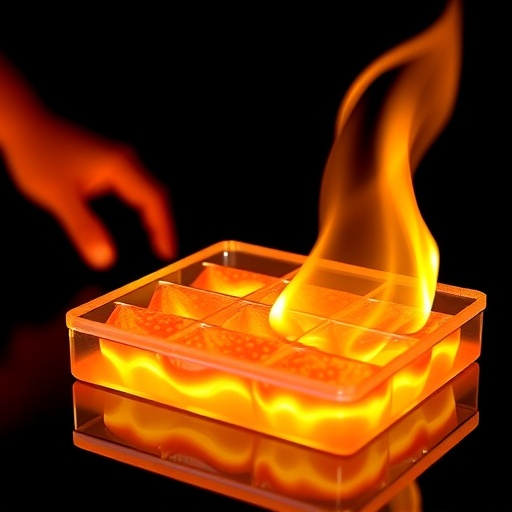In the relentless battle against heat and fire hazards plaguing outdoor electronic devices, scientists have unveiled a groundbreaking advancement that could redefine thermal management technologies. Traditional cooling methods such as fans and air conditioners, while effective in controlled environments, fall drastically short of delivering energy-efficient and environmentally sustainable solutions, especially in the face of escalating global temperatures and intensified solar radiation. Addressing these critical challenges head-on, a team led by Professor Meijie Chen at Central South University, in collaboration with researchers from Brown University, has engineered a state-of-the-art photonic hydrogel that integrates radiative cooling with evaporative cooling—achieving unprecedented heat dissipation performance coupled with inherent flame retardancy.
This novel hydrogel material boasts an all-in-one architecture, masterfully combining the physics of sky radiative cooling and the thermodynamics of water evaporation in a single, versatile matrix. Unlike conventional radiative cooling films that primarily rely on emitting thermal radiation to the cold outer space, this hydrogel also harnesses evaporative cooling—leveraging the latent heat absorption during water evaporation to further suppress temperatures above ambient levels. Importantly, under identical environmental conditions, this dual-mode cooling approach effectuates a remarkable 12.0°C temperature reduction compared to standalone radiative cooling films, paving the way for significant breakthroughs in outdoor electronic device regulation.
The secret behind the hydrogel’s efficacy lies in its ingenious design and composition. The porous matrix is embedded with hexagonal boron nitride (hBN) nanoplates, which serve as efficient solar reflectors, showcasing a high solar reflectance of 87.2%. Simultaneously, lithium chloride (LiCl) within the hydrogel functions as a moisture adsorption-desorption agent, enabling the material to autonomously harvest atmospheric water vapor during nighttime. This moisture is subsequently available for evaporation during daylight, orchestrating a passive water cycle that sustains evaporative cooling without requiring any external water supply—a crucial feature that dramatically expands the hydrogel’s applicability in remote or resource-constrained settings.
Moreover, the material’s thermal emittance in the longwave infrared region (LWIR) reaches an impressive 93.7%, allowing it to efficiently radiate dissipated heat into the vast cold sky. This synergy between high solar reflectance and thermal emittance propels heat dissipation to new heights. The optimized thickness of 6 mm and carefully calibrated water content of 5 weight percent strike an ideal balance between thermal conductivity and water retention, ensuring the hydrogel’s performance is both consistent and robust under varying environmental conditions.
Beyond its cooling capabilities, the hydrogel demonstrates outstanding flame retardancy qualities—an essential breakthrough considering the increasing fire risks associated with outdoor electronic infrastructure. When exposed to open flames, the latent heat absorbed through water evaporation prevents surface temperatures from exceeding 100°C, effectively averting ignition. This passive fire protection mechanism affords an additional safety layer, mitigating thermal runaway events and ensuring the longevity and reliability of high-power devices like 5G base stations, photovoltaic modules, and battery enclosures.
Mechanical versatility is another hallmark of this hydrogel. It exhibits notable flexibility, allowing conformal attachment to diverse substrates including glass, metal, and wood. The strong adhesion and stretchability imbue the hydrogel with the resilience required for real-world applications, accommodating the dynamic physical stresses that outdoor installations routinely encounter.
From an economic perspective, the team prioritized scalability and cost-effectiveness. Using readily available materials such as PDMAPS polymer and mineral fillers like hBN and Al₂O₃, the production cost amounts to a mere $66 per square meter per millimeter thickness. This affordability is crucial to facilitate widespread adoption across industries seeking sustainable thermal management solutions without prohibitive upfront investments.
Extensive outdoor testing validates the hydrogel’s exceptional performance, consistently delivering a 20.9°C temperature reduction compared to bare substrates, and maintaining superiority over conventional radiative cooling films. Crucially, these results hold across continuous day-night cycles, attesting to the material’s all-day operational capability fueled by its integrated atmospheric water harvesting function.
Looking ahead, the research team is keenly aware of the challenges that must be overcome to transition from laboratory prototypes to commercial platforms. Durability enhancements, particularly through corrosion-resistant coatings, are vital to void degradation from prolonged environmental exposure. Beyond this, innovations aimed at further minimizing material costs could accelerate scaling, enabling mass production that meets the demands of global markets focused on green technologies.
The implications of this hydrogel extend well beyond electronics cooling. Its passive, water-autonomous design principles could inspire a new class of smart materials for architecture, wearable devices, and even aerospace applications where thermal regulation and fire safety are paramount. This integrated approach channels the twin forces of photonics and water chemistry, heralding a future where sustainable cooling is not a luxury but a ubiquitous reality.
The work from Professor Meijie Chen’s team thus represents a significant stride toward reimagining how we combat excessive heat and fire hazards in harsh environments. By bridging advanced polymer chemistry with precision nanoscale engineering, they have crafted a multifunctional hydrogel platform that sets a new standard for thermal management technology. As climate pressures mount and energy efficiency becomes non-negotiable, innovations like this photonic hydrogel will be critical enablers for resilient, safe, and sustainable outdoor electronics infrastructure worldwide.
Subject of Research: Radiative and evaporative cooling in photonic hydrogels for thermal management and flame retardancy
Article Title: Radiative Coupled Evaporation Cooling Hydrogel for Above‑Ambient Heat Dissipation and Flame Retardancy
News Publication Date: 1-Sep-2025
Web References: 10.1007/s40820-025-01903-0
Image Credits: Qin Ye, Yimou Huang, Baojian Yao, Zhuo Chen, Changming Shi, Brian W. Sheldon, Meijie Chen*
Keywords
Hydrogels, Radiative Cooling, Evaporative Cooling, Thermal Management, Flame Retardancy, Atmospheric Water Harvesting, Photonic Materials, Hexagonal Boron Nitride, Lithium Chloride, Outdoor Electronics Cooling
Tags: advanced photonic materialsenergy-efficient cooling methodsenvironmental sustainability in electronicsevaporative cooling hydrogelflame retardant materialshybrid cooling technologiesoutdoor electronic device protectionradiative cooling technologysustainable heat dissipationtemperature reduction innovationsthermal management solutionsthermodynamic cooling systems





